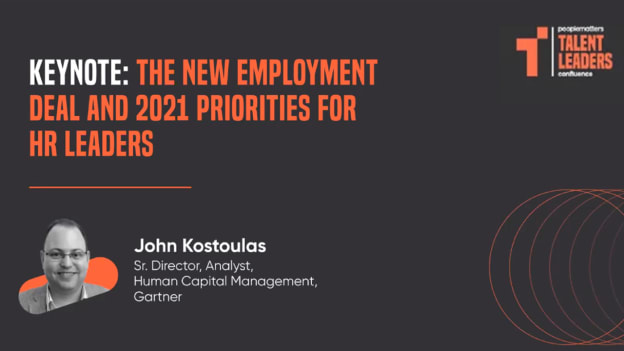The New Employment Deal and 2021 priorities for HR leaders: Insights from TLC

COVID-19 changed the way people think about work, and by doing so, it has changed the employment deal—defined by Gartner as the relationship between employees and employers, which changes over time in tandem with the labor market. So, back in October 2020, Gartner researchers coined the concept of a “new employment deal” arising from the pandemic's exigencies: a more humanized approach that should benefit employees and organizations alike in the post-COVID space.
“When organizations embrace all three dimensions of the new employment deal—radical flexibility, shared purpose, and deeper connections—the number of high performers in the organization's increases by one third,” said John Kostoulas, Senior Director and Analyst, Human Capital Management, with Gartner. Delivering the keynote presentation at People Matters Talent Leaders Confluence on January 20, he explained the three dimensions and how these shape HR priorities for the year.
Radical employment flexibility, shared purpose, and deeper connections
One immediate outcome of the pandemic was enforced flexibility: work locations changed as health and safety concerns kicked in, work schedules changed, and even work quantities changed as hours were reduced or business demands fluctuated unexpectedly.
“Highlighting flexibility in these areas became both a business mandate, and an employee expectation,” Kostoulas explained.
“Many organizations are already seeing talent impacts, based on whether they choose to embrace radical flexibility or not, because even in today's challenging job market employees are turning down organizations that do not meet this new flexibility expectation.”
As he further pointed out, flexibility has not impacted businesses negatively. To the contrary, Gartner research has found that as employers offer more flexibility in terms of when, where, and how much they work, the number of high performers in the organization jumps from 36 percent to 55 percent.
The second dimension of the new employment deal, shared purpose, predates COVID-19, with societal issues from sustainability to gender parity to global mobility having played an increasingly greater role in organizational decision making over recent years. However, employer inaction is no longer an option.
Figures from Gartner indicate that 64 percent of employees have their ability to concentrate on their work affected by recent discussions of racial injustice; three out of four employees expect their employer to take a stand on societal issues even if those issues do not touch the organization's bottom line; and if organizations attempt to dodge the issue by simply making a statement but not following through with action, employees respond by becoming disappointed and disengaged.
The third dimension, deeper connections, arises from the way the pandemic has blurred the boundaries between public and private lives. “COVID-19 has destroyed the idea that work and life can exist as two separate constructs,” Kostoulas said. “Employees' unique individual circumstances, their personal, family and community lives impact their day to day professional reality.”
What this means, he said, is that organizations need to acknowledge how work and life each have a direct impact on the success of the other, and they must take a far more human view of employees, their families and their communities—viewing employees as comprehensive individuals and actively seeking to improve various aspects of their personal lives.
The impact on HR priorities
“HR has a lot of work, but a brilliant opportunity to increase its strategic role by pursuing the new employment deal,” Kostoulas observed. “But at the same time, you as HR leaders have to stay in sync with the business priorities for 2021.”
According to Gartner's research, HR leaders this year are prioritizing the building of critical skills and competencies, and the need to redesign work and the workforce; they are also concerned about leadership succession planning, and about employee experience. These priorities, Kostoulas suggested, give rise to four key themes of action for HR leaders to follow:
Functioning more effectively in the remote/hybrid world of work: going beyond technology and logistics, leaders now have to address more important questions of critical managerial and leadership roles and responsibilities, organizational structures, and virtual HR strategies.
Efficient resilience: 2020 has shown that efficient organizations are actually fragile organizations, and HR leaders need to work towards resilience—in the organization, the leaders, and the individual employees—to enable a better recovery from disruption.
Diversity in leadership: with so many other urgent priorities to attend to last year, diversity fell behind, but expectations from the workforce and the community have not.
The new employment value proposition: employee expectations have shifted, as the need for purpose, connection, diversity, and most recently mental well-being shows. HR leaders have to continue finding ways to meet these expectations, so as to meet the organization's talent needs.
With the disruption and uncertainy of 2020 likely to continue at least into the first half of 2021, HR will continue to have a full plate, Kostoulas said, and the priorities and themes he spoke on should be thought of as long term investments rather than short-term solutions.
“HR remains under pressure to respond to emerging events, without losing sight of longer term challenges and opportunities,” he observed. “It is not only the next step that matters, but clearly visualizing the destination.”















